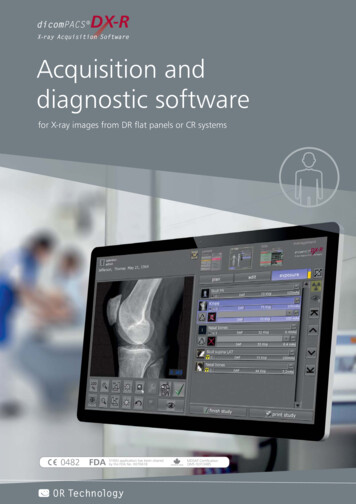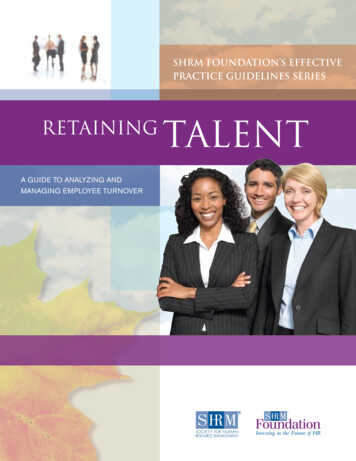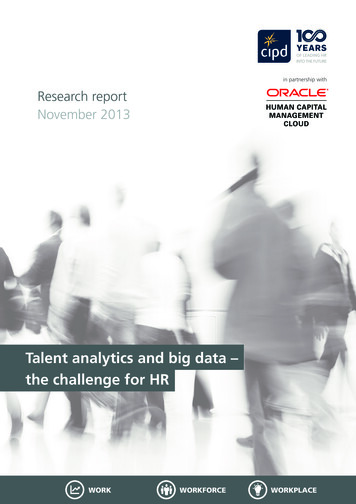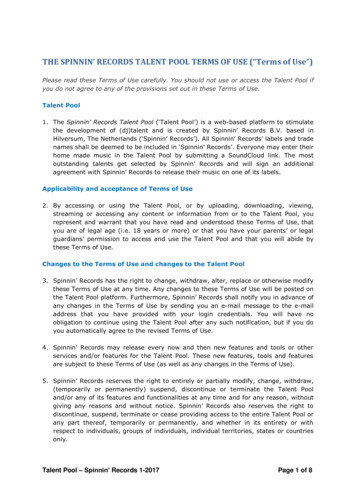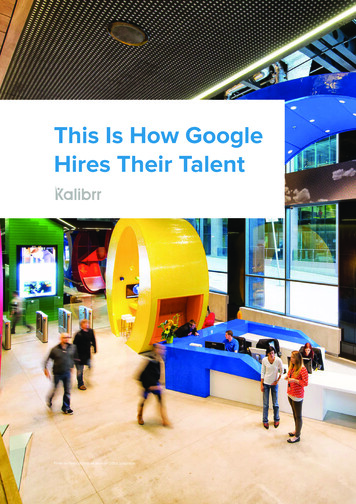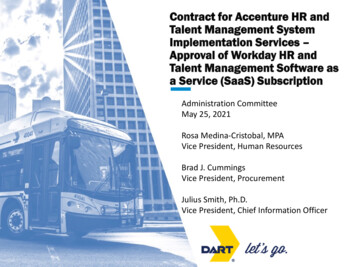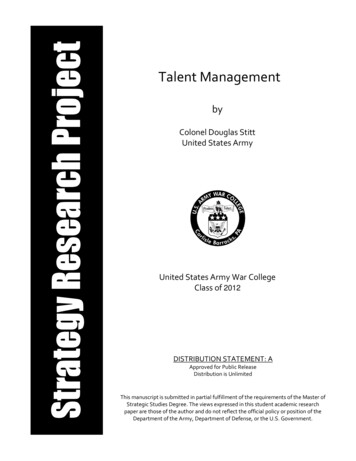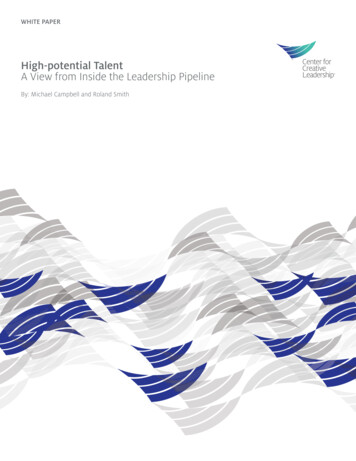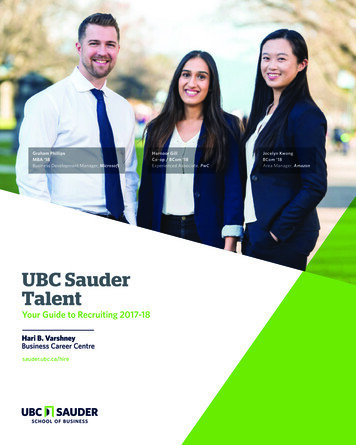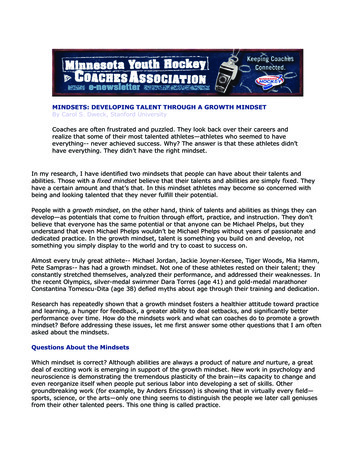
Transcription
Talent Acquisitionat Scale:Avature Sets the Pace
Talent Acquisition at Scale:Avature Sets the Pacecontingent recruiting, and onboarding. And today a newTalent acquisition is one of the most complex operationsThe average recruiting function has more than 20 differentin business. Companies are continuously looking for newsystems and as they stitch them together the operationsemployees and today the challenge is more dynamic than ever.become complex, the data is hard to manage, and the userNot only has every job been transformed by the pandemic,experience becomes difficult for employees, managers,organizations are relocating jobs to new cities, changingrecruiters, and job candidates.job roles to accommodate new low-touch business models,And the innovation keeps coming. Each year there are dozensand continuously competing for high-demand skills like AI,of startups in talent acquisition. Emerging are companies thatcybersecurity (the most in-demand role in IT), softwaresource candidates in unique ways, provide talent networks ofengineering, and many roles in science, healthcare delivery, andspecialized people, sell new tools for testing and assessment,functional operations.and offer AI tools for analytics and candidate communication.And recruitment is a highly strategic function. It not only setsThe technology ecosystem for talent acquisition has becomethe stage for growth, it creates a brand in the market – invitingso complex that most large companies have a technology teamtop people to join the company and creating an experiencededicated to talent acquisition systems.that not only attracts great people but also reinforces theBecause the market is so massive, the space attracts hundredscompany’s culture.of vendors and billions of dollars of venture capital. Broadlyrequirement has emerged -- tools that enable internal talentmobility through a talent marketplace.speaking, companies in this market fall into the categories ofTechnology Platforms Are FragmentedTechnology plays a major role. If you think about the processlike a supply chain, one would think talent acquisition is like ansourcing, assessment and testing, video interviewing, candidaterelationship management, background checking, interviewscheduling and offer management, onboarding and analytics.ERP application. But it’s far more complex.We need tools to advertise and attract candidates from manyAvature: A Unique Player in the Marketsources; search and communicate with candidates; scheduleOver the years, many vendors have tried to build end-to-endcampus visits and events; manage referrals from employeestalent acquisition platforms, often with limited success. Taleoand others; assess, video-interview, and test people; andwas one of the early leaders, but it fell behind other innovatorsmanage interviewing, background checking, job offer creation,and is now owned by Oracle. Kenexa built and acquired manyFinding Great CandidatesBringing Candidates into the CompanyAdvertisingCreating job requisitions with hiring managersSourcingMaintaining visibility of the pipelineAssessmentAssessing candidates strategicallyScreeningCreating competitive job offersPre-hire assessmentSelling candidates on the company and the jobInterviewingBackground check and reference checkingUniversity eventsClosing a new hireCandidate communicationsOnboarding and ongoing trainingAnalyzing sources, advertising, experienceAnalyzing performance of hiresFigure 1: Examples of functional needs in talent acquisition2TA L E N T A C Q U I S I T I O N AT S C A L E :AVAT U R E S E T S T H E PA C E
tools but also could not keep up and was eventually acquiredsimplified workflows, and all sorts of reports specific to the localby IBM (and essentially closed down). Lumesse was acquiredmarket. Or what if a global pandemic suddenly turned yourby Saba and then Cornerstone; PeopleClick was acquiredrecruiting and hiring processes upside down?by PeopleFluent and then LTG. JobVite was merged withAvature lets you create this customized solution yourself. AsRolePoint and Canvas. Vendors like Greenhouse and manyyou’ll learn from the stories below, building these applicationsothers continue to try to keep up.does not require any work from IT. The system itself isWhy such churn? These products take deep investment in R&D,designed so that anyone can add new fields, create a workflow,continuous innovation, and lots of domain expertise.design a new screen or portal, create a report and set up alerts,ERP vendors such as Oracle, Workday, SAP, Ultimate, andvarious manager approvals, and set up thresholds and otherADP are all building systems, but they also have a hard timebusiness rules.keeping up. Even the highly successful, focused vendors (iCimsThe market for recruitment is similar to the overall market forand others) struggle to stay ahead. And to the churn is that theHCM. While vendors like Workday, SAP, Oracle, and ADP try totalent acquisition leaders in global enterprises are continuingbuild end-to-end solutions, companies badly need customized,to replace their platforms to obtain more functionality.workflow-enabled employee applications, so they now buyOne big problem is system adaptability. As a company startsServiceNow as a layer in between.to tweak, adapt, and expand its recruiting practices, there areAvature, similar to ServiceNow, can be configured to doalways new workflows, business rules, and reports to add.almost anything and now has all of the core features any largeRecruiting is not a transactional process – it’s more like acompany demands. In fact, the consistent story I heard in allcontinuous flow – so the platform has to be adaptable and easymy interviews was that with Avature, TA leaders now could doto change. This means the architecture has to be built aroundalmost anything needed without having to hire an engineer ora workflow engine, one that can be configured by users andthe vendor to modify the system.customized for each company.Avature was built for this. Originally designed as a candidaterelationship system, Avature was architected to scale fromthe beginning. The founder realized early that the processof candidate communications was highly configurable, so hebuilt a system which is easy to configure, adapt, and change.And now that Avature has expanded into all areas of talentacquisition (from sourcing to video interviewing to schedulingto onboarding and even internal talent mobility), it hasemerged as one of the most adaptable platforms in the market.And this means it can scale.CiscoCisco fills about 15,000 jobs each year. Given the rapid changesin Cisco’s business (product lines like WebEx are experiencingexplosive growth), this hiring pipeline is always active, alwayschanging, and always important. The HR operations teamnow uses Avature for the entire process of recruiting and hasextended its workflow capabilities to automate candidaterelationship management and manage “silver medalists” (greatcandidates who did not get the job but which whom Cisco wantsto keep in touch). This workflow lets Cisco promote new jobsto these candidates because there are often new opportunitiesCustomers Deploy Avature for ManyApplications in TAI talked with many of Avature’s customers and I kept hearing3that can be filled by these highly qualified people. Cisco also usesAvature to manage alumni and automate communications andongoing feedback for this critical talent segment.the same thing. These companies had used tools from providersAvature’s workflows tools let Cisco manage many talentsuch as Taleo or iCims in the past but kept finding the systemssegments: external candidates, internal candidates, andlimiting in some way. Imagine you want to hire people in a newexecutive recruits. The executive recruiting instance iscountry, and you set up a local recruiting team. The team willseparated to maintain privacy, but it also uses the flexibility ofneed language support, as well as custom candidate marketing,Avature for process management. When it comes to internalunique candidate leads, custom fields and manager dashboards,candidates, Cisco has pioneered the strategy of internalTA L E N T A C Q U I S I T I O N AT S C A L E :AVAT U R E S E T S T H E PA C E
mobility and has encouraged people to move internally forcould automate and integrate the entire global process. Mikemany years. As a result, 40% of open requisitions are now filledbelieves Avature is one of the most consultative vendors hewith internal candidates -- a very high percentage.has worked with. Similar to Cisco, the Siemens TA team foundSince the platform is so flexible, implementation is not a processthat Avature would sit down with them, help them define theof “turning on the system” but rather one of walking throughprocesses they needed, and showed them how to build theseyour processes and then “turning them on” in Avature. Ciscoworkflows in Avature.uses Webex for video and virtual interviews, Outlook forWhen I asked Mike the biggest benefit of Avature, he saidinterview scheduling, HackerRank for technical assessments,it came down to two things, both of which are focused onand a third party chatbot – all integrated into the Avaturemoving from a “post and pray” to “seek and sell” TA approach.workflow.First, Siemens needs to free up recruiters to “sell Siemens” toThe candidate and hiring manager experience is also managedcandidates, so Avature simplifies their day so they can focusby Avature. Since some hiring managers don’t frequently hire,on listening to candidates and helping them understand whythe interface has to be simple and easy to use. For candidates,Siemens is a good fit. As many TA leaders have told me, greatAvature is used to manage a wide variety of career websites thatrecruiters attract great candidates. Second, Mike believeshelp candidates find the right job within Cisco’s broad business.Avature gives recruiters, candidates, and hiring managersOne of the biggest benefits of Avature is its extensibility.Cisco’s operations team is constantly asked by HR tothe right experience so they all feel engaged, informed, andinvolved in the process.implement new workflows (new managerial approvals, newPrior to Avature, managers had to input almost 35 differentjob assessments, contingent work roles, skills-based hiring)pieces of information to create a job opening. Now a hiringand in almost every case, Avature can be reconfigured to meetmanager just opens a “hiring demand” through a portalthese needs. The person I interviewed said about the system,and only needs to specify the job title and location. The“There’s nothing Avature can’t do.”recruiter then talks with the hiring manager and fills out allFinally, the Cisco team has found Avature to be agile andresponsive to its needs, with new features being added ona regular basis. Last year, Cisco hosted a set of Avaturethe information needed. Recruiters are aligned by businessunit and function, so they get to know the jobs and the hiringmanagers well.customers to talk about talent acquisition needs, and the teamOnce the requisition is open, hiring managers can use thathas found the Avature customer network to be another greatsame portal to track the progress of the hire in real time, whichbenefit of the relationship.keeps the recruiter, HR business partner and hiring managerwell aligned throughout the process. This frees up the recruiterSiemens Energy4to manage a process that features embedded video interviewtechnology, job post editing tools, and LinkedIn sourcing tools.Siemens Energy provides building and energy solutionsToday, every recruiter in the world has access to the data theyglobally with around 90,000 employees and revenues greaterneed to view all key activities and share global pipelines. Thisthan 28 billion euros. As the company continues to grow andmeans recruiters can quickly collaborate on hiring projectsevolve this business, the talent acquisition team wants to makeor candidates and even work together on a senior requisitionsure its recruiting is strategic, highly optimized, scalable, anditself. Since the CRM and ATS are integrated, recruiters seebuilt around a strong employment brand.campaigns, candidates, and all related processes in one system.How did Siemens select Avature? The head of talentNow that the system is fully implemented, Siemens usesacquisition, Mike Brown, found Avature to be the mostAvature for sourcing, referrals, event management, interviewcomplete, integrated, configurable system he had ever seen.scheduling, as well as the end-to-end process of applicantInitially Siemens was looking for a CRM system, but as thetracking. Today Siemens globally hires more than 40,000TA team looked at the functionality of Avature, it realized itpeople per year, all managed by Avature. The next step is toTA L E N T A C Q U I S I T I O N AT S C A L E :AVAT U R E S E T S T H E PA C E
work with Avature on contingent hiring, which currently isrecruitment toward unique audiences. The system also letsmanaged by Fieldglass.recruiters ask candidates important self-select questions like“when are you looking to move?”, making its targeting evenL’OréalIn the United States, L'Oréal hires and moves around 1,200more effective over time.has 30-plus recruiters and about 120 HR professionals overall.Bottom Line: Talent AcquisitionTechnology That ScalesRecruiting covers all corporate roles including sales, IT,I am an industry analyst and have no reason to push oneoperations leadership, and engineering roles. The company hadproduct over another. For many years, I’ve looked at recruitingused Kenexa (acquired by IBM) and PeopleFluent (formerlycompanies and have been amazed at the functional innovationknown as Peopleclick) and used an on-premise solution,and depth in their products, only to find later that the companyEncore, for candidate relationship management. In 2014,was acquired by a larger provider. The reason for all this churnthe company globally transitioned to Avature as these otheris that talent acquisition has three unique characteristicssolutions fell behind in the market.(similar to L&D):Avature has now become L'Oréal’s end-to-end platform for senior people per year in its corporate operations; the companytalent acquisition. What TA leaders like about Avature isthe ability to customize the system easily and its reportingcapabilities.Prior to implementing Avature, it took weeks or months to pulltogether data and run reports which then quickly went outHigh complexity with many workflows and functionalneeds The need for customization, unique to each customer Constantly changing requirements as the customercompany grows and evolvesof date. In Avature, the same reports are all real-time and canOne of the reasons Avature has been able to build a configurablebe shared with hiring managers, recruiters, or anyone in theand scalable platform is that the company is privately held andcompany to aid in decision making. Since Avature is an end-to-still owned by its founder, Dimitri Boylan. Dimitri has a long-end platform, L’Oréal now has access to data across every stepterm business view, and he is willing to build a platform (not ain the process and the team is able to analyze talent acquisitionproduct) that scales. Over the last five years, Avature has fullyin more detail.built out candidate relationship marketing, video interviewing,The company is also leveraging Avature to track gender andethnic diversity through the recruiting process and to findareas where the diversity mix may change. For example, a TAleader may look at diversity by ad campaign, source, recruiter,hiring manager, role, geography, or source company. This helpsapplicant tracking, internal mobility, skills and job architecture,and tools for reporting, onboarding, and more. In many ways,it is a configurable talent management system as well; Dimitriand his teams are building functionality around goals andperformance and learning as well.the team modify its recruiting investments to continuouslyWhile I know many companies will do fine with the otherimprove diversity, candidate quality, and cost to hire.products on the market, Avature’s unique blend of adaptability,Because Avature is easy to use, L'Oréal has empowered itsrecruiters to do many of this analysis themselves. It only takesa few days for recruiters to learn how to use the system and,flexibility, and ease of configuration and use is quite a uniqueoffering. I encourage you to think about these issues as youlook at HR platforms for your company.very quickly, they become highly effective at using Avature astheir toolbox.And if L'Oréal decides to capture additional information fromcandidates, Avature lets the company attach forms to ask newquestions – customized by job, location or level. This helpsL'Oréal dramatically improve its pipelining strategy to target5TA L E N T A C Q U I S I T I O N AT S C A L E :AVAT U R E S E T S T H E PA C E
About Josh BersinJosh Bersin is an internationally recognized analyst, educator, and thought leader focusing onthe global talent market and the challenges impacting business workforces around the world. Hestudies the world of work, HR and leadership practices, and the broad talent technology market.He founded Bersin & Associates in 2001 to provide research and advisory services focused oncorporate learning. Over the next ten years, he expanded the company’s coverage to encompassHR, talent management, talent acquisition, and leadership. He sold the company to Deloitte in2012, when it became known as Bersin by Deloitte. Bersin left Deloitte in 2018.In 2019, Bersin founded the Josh Bersin Academy, the world's first global development academyfor HR and talent professionals and a transformation agent for HR organizations. The Academyoffers content-rich online programs, a carefully curated library of tools and resources, and aglobal community that helps HR and talent professionals stay current on the trends and practicesneeded to drive organizational success in the modern world of work.Bersin is frequently featured in talent and business publications such as Forbes, Harvard BusinessReview, HR Executive, FastCompany, The Wall Street Journal, and CLO Magazine. He is a regular keynote speaker at industry eventsaround the world and a popular blogger with more than 800,000 followers on LinkedIn.His education includes a BS in engineering from Cornell University, an MS in engineering from Stanford University, and an MBA from theHaas School of Business at the University of California, Berkeley.6TA L E N T A C Q U I S I T I O N AT S C A L E :AVAT U R E S E T S T H E PA C E
such as Taleo or iCims in the past but kept inding the systems limiting in some way. Imagine you want to hire people in a new country, and you set up a local recruiting team. The team will need language
